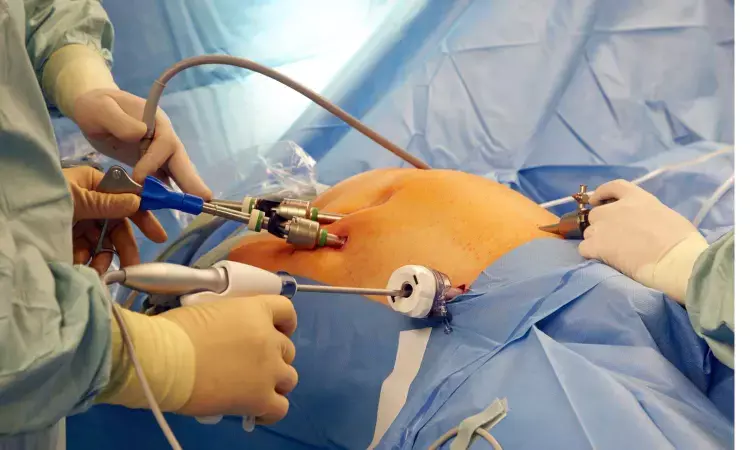- Home
- Medical news & Guidelines
- Anesthesiology
- Cardiology and CTVS
- Critical Care
- Dentistry
- Dermatology
- Diabetes and Endocrinology
- ENT
- Gastroenterology
- Medicine
- Nephrology
- Neurology
- Obstretics-Gynaecology
- Oncology
- Ophthalmology
- Orthopaedics
- Pediatrics-Neonatology
- Psychiatry
- Pulmonology
- Radiology
- Surgery
- Urology
- Laboratory Medicine
- Diet
- Nursing
- Paramedical
- Physiotherapy
- Health news
- Fact Check
- Bone Health Fact Check
- Brain Health Fact Check
- Cancer Related Fact Check
- Child Care Fact Check
- Dental and oral health fact check
- Diabetes and metabolic health fact check
- Diet and Nutrition Fact Check
- Eye and ENT Care Fact Check
- Fitness fact check
- Gut health fact check
- Heart health fact check
- Kidney health fact check
- Medical education fact check
- Men's health fact check
- Respiratory fact check
- Skin and hair care fact check
- Vaccine and Immunization fact check
- Women's health fact check
- AYUSH
- State News
- Andaman and Nicobar Islands
- Andhra Pradesh
- Arunachal Pradesh
- Assam
- Bihar
- Chandigarh
- Chattisgarh
- Dadra and Nagar Haveli
- Daman and Diu
- Delhi
- Goa
- Gujarat
- Haryana
- Himachal Pradesh
- Jammu & Kashmir
- Jharkhand
- Karnataka
- Kerala
- Ladakh
- Lakshadweep
- Madhya Pradesh
- Maharashtra
- Manipur
- Meghalaya
- Mizoram
- Nagaland
- Odisha
- Puducherry
- Punjab
- Rajasthan
- Sikkim
- Tamil Nadu
- Telangana
- Tripura
- Uttar Pradesh
- Uttrakhand
- West Bengal
- Medical Education
- Industry
SADI or SASI bariatric surgery, which is better for long-term weight loss?

Australia: A systematic review has shown that single anastomosis duodenal-ileal (SADI) bypass and single anastomosis sleeve-ileal (SASI) bypass can effectively induce weight loss at 12 months, with a low mortality rate and significant complications.
The SASI procedure was shown to have a higher impact on the resolution of type 2 diabetes mellitus (T2DM) than SADI, as implied from the studies included in the review published in Expert Review of Endocrinology & Metabolism. T2DM resolution was achieved in 78.5% of patients in the SADI group and 89.0% in the SASI group. Complication rates were similar for both procedures.
Previous studies have shown the long-term effectiveness of bariatric surgery in improving metabolic parameters for obesity and inducing weight loss. Both single anastomosis duodenal-ileal bypass and single anastomosis sleeve-ileal bypass have emerged as promising bariatric procedures. In the new research, Hye Rim Suha, University of New South Wales, Kogarah, NSW, Australia, and colleagues reviewed the existing literature and compared the outcomes of SASI and SADI bypass procedures concerning complication, weight loss, and improvement of type 2 diabetes. According to the authors, this has not been performed in the preexisting literature.
Rim Suha and the team conducted a systematic literature search of electronic databases focused on weight loss outcomes, improvement of type 2 diabetes and other obesity-related comorbidities, and rate of remission and complications. The review comprised nine studies on SASI and seventeen studies on SADI.
The authors reported the following findings:
- Both procedures are similar in surgical technique and have demonstrated fewer complications than other bariatric procedures.
- Mean preoperative BMI was similar in both study groups: 46.4 kg/m2 in SADI and 48.8 kg/m2 in SASI.
- The mean %EWL at 12 months in the SADI group was 74.1% compared to 77.4% in the SASI group.
- Preoperative severity of T2DM appeared to be higher in the SASI patient group, with higher preoperative HbA1c and fasting blood glucose levels.
- T2DM resolution was achieved in a significant proportion of SADI and SASI patient populations (78.5% in SADI and 89.0% in SASI).
- Complication rates were comparable for both procedures.
"The findings revealed that both SASI and SADI effectively induce weight loss at 12 months, with a low mortality rate and major complications," the researchers wrote. "From the studies included in this review, the SASI procedure had a higher impact on type 2 diabetes resolution than SADI."
Reference:
Hye Rim Suh, Jasmine Mui, Ernest Cheng, Daniel Liu, Si Louise Sun, Ken Loi, Mark Magdy & Michel Gagner (2023) Outcomes of single anastomosis duodeno ileal bypass and single anastomosis stomach ileal bypass for type II diabetes: a systematic review, Expert Review of Endocrinology & Metabolism, DOI: 10.1080/17446651.2023.2218919
Dr Kamal Kant Kohli-MBBS, DTCD- a chest specialist with more than 30 years of practice and a flair for writing clinical articles, Dr Kamal Kant Kohli joined Medical Dialogues as a Chief Editor of Medical News. Besides writing articles, as an editor, he proofreads and verifies all the medical content published on Medical Dialogues including those coming from journals, studies,medical conferences,guidelines etc. Email: drkohli@medicaldialogues.in. Contact no. 011-43720751


